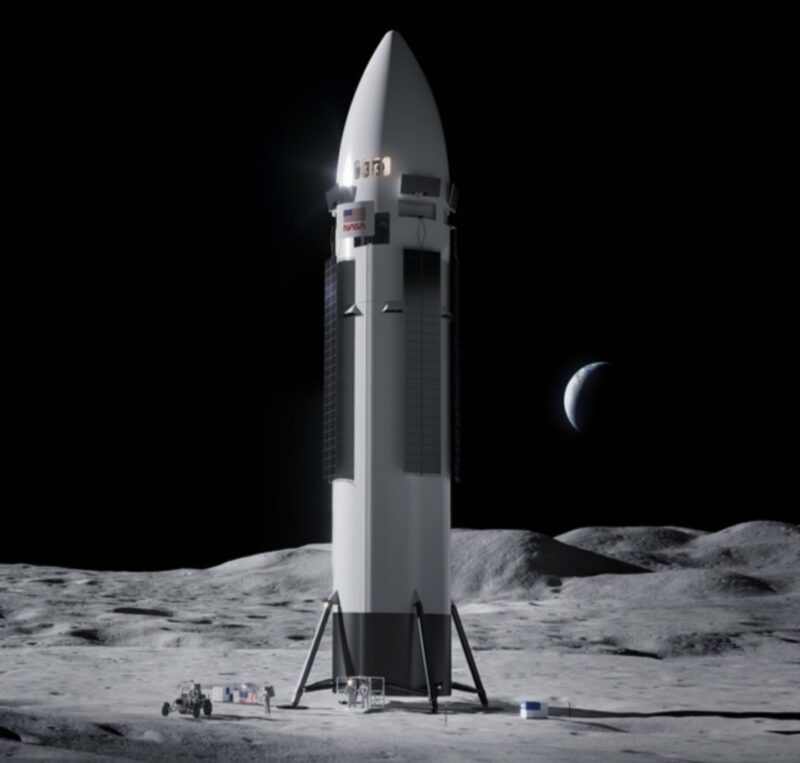
NASA and its team of commercial and international partners are making rapid progress towards their goal of returning to the Moon within a handful of years. The Artemis program’s momentum has grown with an impressive string of accomplishments. Less than a year ago, NASA completed the Artemis 1 mission, a nearly flawless test of the SLS rocket and the Orion crew capsule. Reid Wiseman, Victor Glover, Christina Koch, and Jeremy Hansen were announced as the crew of the Artemis 2 lunar flyby in April, and they are well into their training. Both of these missions will lay the groundwork for Artemis 3, the first crewed lunar landing in over half a century.
One of the highest-profile elements of the Artemis architecture is SpaceX’s Starship lunar lander, the vehicle responsible for carrying astronauts from lunar orbit to the surface of the Moon during Artemis 3 and 4. After Starship’s dramatic debut in April, there has been some uncertainty surrounding the vehicle’s status and the launch date for Artemis 3. However, recent statements from NASA and SpaceX officials shed light on the effort to develop this highly-capable vehicle. Even more notably, newly-leaked renders from SpaceX reveal that the lunar Starship’s design has undergone significant revisions since its development began two years ago.

With its Human Landing System (HLS) program, NASA is taking a new approach to deep space exploration. The program’s goal was to accelerate the schedule and decrease the cost of the Artemis program by buying lunar landers from commercial vendors. In April 2021, NASA selected SpaceX’s Lunar Starship as the first recipient of an HLS contract. In part, SpaceX won the initial HLS contract because, as a derivative of a commercial rocket, Starship was more affordable than its competitors’ offerings. Starship is the second stage of SpaceX’s next-generation, fully-reusable launch vehicle. At 164 feet (50 meters) in height, it dwarfs its predecessor, the Apollo Lunar Module. Starship offers a spacious crew cabin for the astronauts and a massive 100-ton claimed payload capability.
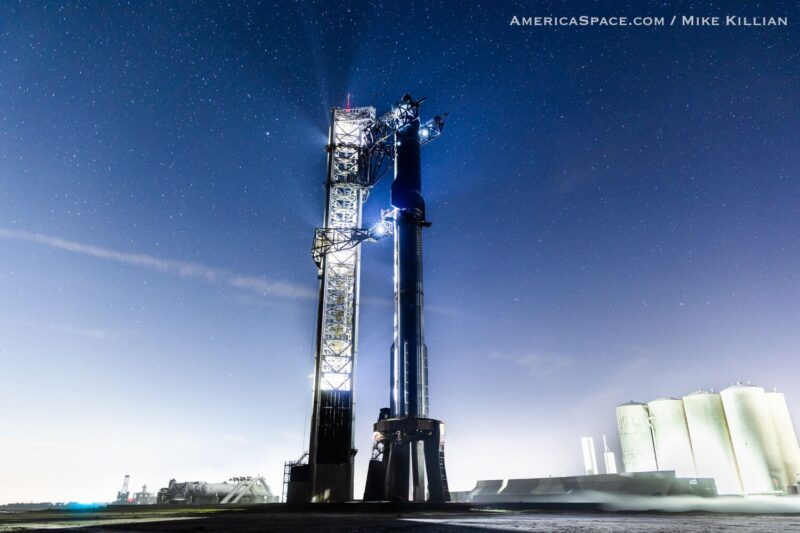
SpaceX’s approach to lunar landings relies on orbital refueling, which will be implemented on a large scale for the first time. According to Lakiesha Hawkins of NASA’s Moon to Mars program office, nearly 20 Starships will need to be launched as in-flight tankers or fuel depots [1]. These vehicles will contain liquid methane and liquid oxygen, which are to be transferred to a specialized variant of Starship that has been optimized to land on the Moon. This complicated architecture has induced risk to Artemis 3’s schedule. The recent second Integrated Flight Test of Starship demonstrated impressive progress towards the program’s initial goal of reaching orbit, but a lengthy sequence of technology development and in-orbit tests still lies ahead before Artemis’ first crewed lunar landing.
When NASA selected SpaceX as the winner of the HLS contract, the company released a rendering of its lunar lander. At the time, the vehicle broadly resembled a standard Starship, albeit with its aerodynamic control flaps and heat shield tiles removed. The crew would have accessed the lunar surface via an elevator, and power would have been provided by a small ring of solar panels around the lander’s nose. Since then, Starship HLS’s design has changed significantly. NASA and SpaceX have optimized their lander to surmount the unique challenges presented by lunar exploration.

On November 2nd, two purported renderings of the Starship Human Landing System’s new design were leaked by the writer David Willis on X, the site formerly known as Twitter [2]. AmericaSpace cannot confirm the authenticity of these illustrations, and the author did not respond to a request for comment via e-mail. However, the rendering of Starship on the lunar surface has an identical backdrop to SpaceX’s previous official depictions of the vehicle. If they are, indeed, genuine, these renderings reveal several fascinating modifications to the lunar Starship’s design. These improvements further differentiate HLS from other variants of Starship, and they will enhance its ability to successfully complete the Artemis 3 mission.
To begin, the new design of the Starship lander is taller than its previous iterations. Active Starship prototypes stand 164 feet (50 meters tall); the same was true of the initial HLS design. All Starship variants are assembled out of the same 30-foot (9-meter) stainless steel rings. Therefore, by comparing the height-to-width ratio of the old and new renderings, we can deduce that the revised HLS design is roughly 180 feet (55 meters) tall. As early as December of 2021, SpaceX CEO Elon Musk hinted that his company might increase the size of Starship’s propellant tanks. This rendering provides confirmation that this enhancement is still part of SpaceX’s plans. By stretching Starship’s propellant tanks, SpaceX will be able to load more fuel into the lander. This decision could be an effort to enhancing Starship’s performance for lunar missions, which require significantly more delta-V (change in velocity) than flights to low-Earth orbit. In addition, HLS Starship must loiter in orbit around the Moon for up to 100 days while it waits for its crew to arrive. Larger propellant tanks would allow it to carry enough liquid methane and liquid oxygen to land, despite the loss of propellant through boil-off to space.

SpaceX also tweaked the lander’s paint scheme. In every rendering released to date, HLS has been painted white. This veneer is not just cosmetic. White surfaces reflect nearly 100% of incoming solar radiation, which reduces the rate at which propellant boils off. While this remains true for most of the vehicle, the new renderings reveal that its engine section is painted black. It is unclear why this decision was made. Black surfaces absorb the bulk of incoming solar radiation, which might help keep Starship’s six Raptor engines warm in the frigid lunar shadows.
Beyond minor changes in deployment angle and spacing, Starship’s four landing legs appear to be relatively unchanged. However, they are no longer housed inside enclosed aerodynamic fairings. Instead, they simply seem to be retracted and flush against the lander’s body during launch. This decision suggests that the landing gear are strong enough to withstand the gale of wind which rushes past a rocket at hundreds of miles per hour as it ascends through the atmosphere. Additionally, it implies that Starship’s Super Heavy booster will produce enough thrust to negate the drag from these four protuberances.
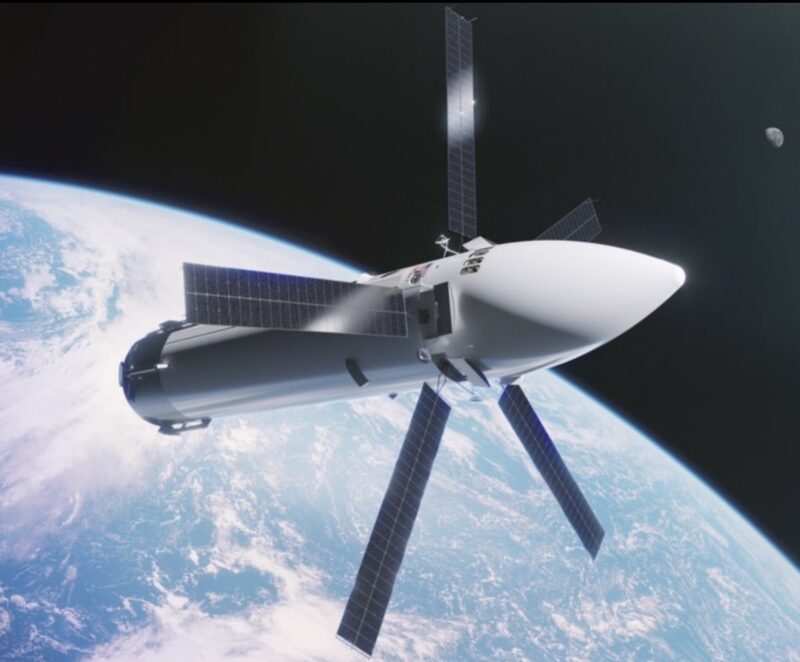
The most obvious additions to the Starship lunar lander are its five large solar arrays. These arrays will serve as the lander’s primary source of energy in space and on the lunar surface. During launch, each solar array is housed within a rectangular compartment beneath the crew cabin. Depending on the design which SpaceX has elected to use, they will then unfold or unroll to a deployed length of approximately 60 feet (18 meters). The solar arrays are spaced 30 degrees apart in a hexagonal pattern. One panel is omitted to give Starship’s commander and pilot a clear view of the lunar surface during landing and to deploy an elevator for the Moonwalkers.
While the HLS is orbiting the Earth or the Moon, the solar arrays will be oriented perpendicular to its propellant tanks. The spacecraft will point its nose towards the Sun so that all five arrays can generate power. It would not be surprising if they are retracted during landing so that they are not damaged by vibrations or by rocks and regolith kicked up by the engines, although this is not confirmed by the renderings. Once Starship is on the lunar surface, the arrays will rest against the lander’s body. At the lunar South Pole, the Sun is always near the horizon. This vertical orientation will therefore maximize the amount of energy which the lander can collect on the Moon. It is worth noting that these solar arrays likely have a larger collective surface area than the small cylindrical array which was featured in earlier renderings. Therefore, it is possible that the lander’s power requirements have grown. The increased energy budget might be used to power the 450 kilograms of instruments which Artemis 3 will carry, to run cryocoolers which could prolong the storage of liquid oxygen and liquid methane, or for another purpose entirely.
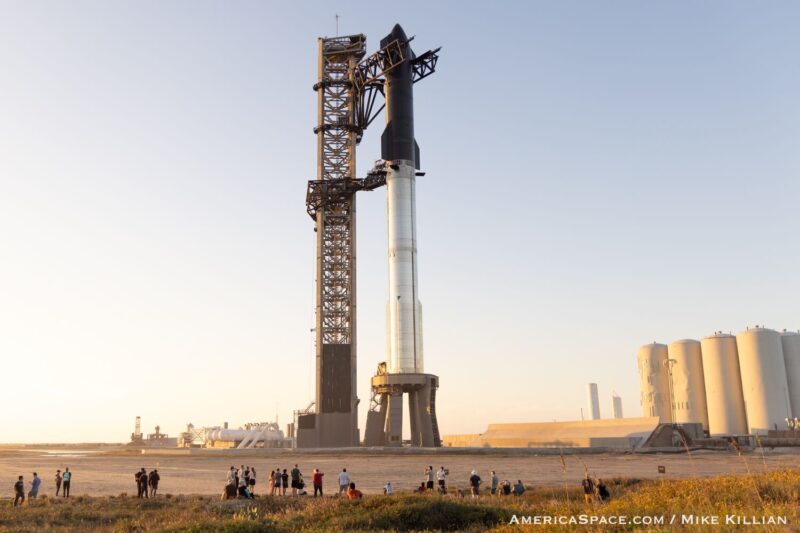
A recent NASA paper seemingly confirms that deployable solar arrays of some sort are in development [3]. In this publication, the HLS team stated, “SpaceX has conducted development testing and analyses on crew displays, crew elevator, hot gas reaction control system, solar array deployment, thermal and micro meteoroid debris protection tiles, landing legs, docking mechanisms, landing software & sensors, (and) medical systems.”
According to the leaked renderings, the solar array compartments will also house six communications antennae. They will be interspersed between the solar panels in a hexagonal pattern. Multiple communications systems will enable Starship to relay information to Earth, Orion, astronauts on the lunar surface, and, eventually, the Gateway space station in lunar orbit.

The new renderings also confirm that Starship HLS will be equipped with small landing thrusters beneath its crew cabin. The majority of Artemis 3’s powered descent will be conducted by the Raptor engines. However, these six powerful engines would likely generate severe plume-surface interactions during landing, excavating large quantities of rock and regolith from beneath the lander. Instead, Starship will be gently lowered to the lunar surface by these small, elevated thrusters. Previously, the status of the landing thrusters was unclear. During a presentation at the 2023 International Astronautical Congress, Elon Musk expressed his hope that “Starship should be a generalized transport system to anywhere in the Solar System. I am sort of optimistic that we can take a Starship that’s fairly unmodified from what would land on Earth – obviously, you would need landing legs – on the Moon.” [4] While this approach would reduce the complexity of the lander, this benefit must have ultimately been outweighed by the risk posed by potential flying debris.
NASA HLS Program Manager Lisa Watson-Morgan seemingly confirmed this decision at the American Astronautical Society’s von Braun Symposium. She said, “We had a cold-start Raptor Vacuum test that was recently completed. (SpaceX is) also working on smaller thrusters.” [5] Lunar Starship’s revised design features 18 landing thrusters distributed amongst six pods. The protruding housings are another new addition to the design. They point the thrusters directly towards the lunar surface, which will maximize their efficiency during descent.
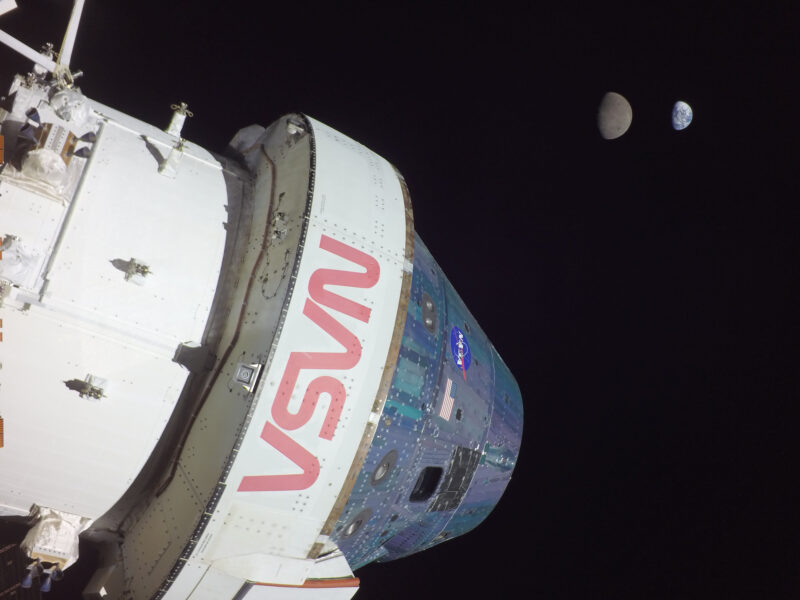
One question which is not definitively resolved by the renderings is how Orion will dock with Starship. Originally, the Artemis 3 crew’s capsule was slated to dock to the HLS’s nose. However, the lander’s nose cone is now encapsulated by a rounded fairing. One possibility is that Starship’s docking port could have been repositioned to the side of the vehicle. The rendering of HLS in orbit around the Earth shows a circular silver structure which is superimposed on the square hatchway which the astronauts will use to access the lunar surface. If this panel also incorporates the docking adapter for Orion, the astronauts would float directly into the unpressurized bay which will house Starship’s airlock, elevator, and scientific equipment. This configuration would be similar to the Space Shuttle’s airlock, which its crews used to board the International Space Station. Alternatively, the hatch could be protected by a retractable cover on Starship’s nose, and the unidentified silver structure could serve an alternative purpose.

The layout of Starship’s crew cabin also remains relatively mysterious. In previous artist’s concepts, two seats were visible through the lander’s windows. While the new renderings have a lower resolution, the seats oddly still appear to be present. Apollo astronauts stood during terminal descent. Their Artemis counterparts will still require a decent view of the lunar surface, especially in the final phase of descent and landing. Seats for lunar landers are nothing new. In fact, Grumman’s original models of the Apollo Lunar Module featured seats for the astronauts. At some point in the LM design process, the LM seats were removed to save weight, both on the seats themselves and on the large amount of glass needed for the astronauts to have a good view of the landing area. It was found that the closer the Apollo astronauts were to the lunar lander descent windows, the greater the improvement to their viewing angles. The Apollo experience demonstrates that legs are sufficient shock absorbers in the Moon’s 1/6 of Earth’s gravity.
Watson-Morgan is pleased with her team’s progress on the design of the crew cabin. Her remarks at the von Braun Symposium indicate that HLS team is already addressing its details. “We’re working through medical kit testing, training system delivery, (and) crew displays,” she said [5]. “We’ve worked through how we’re going to handle mission authority on the day of launch.” SpaceX recently scrapped Ship 22, one of its obsolete Starship prototypes, and converted its nose cone into a HLS mockup. It will likely be used to evaluate potential cabin designs and to eventually train astronauts.
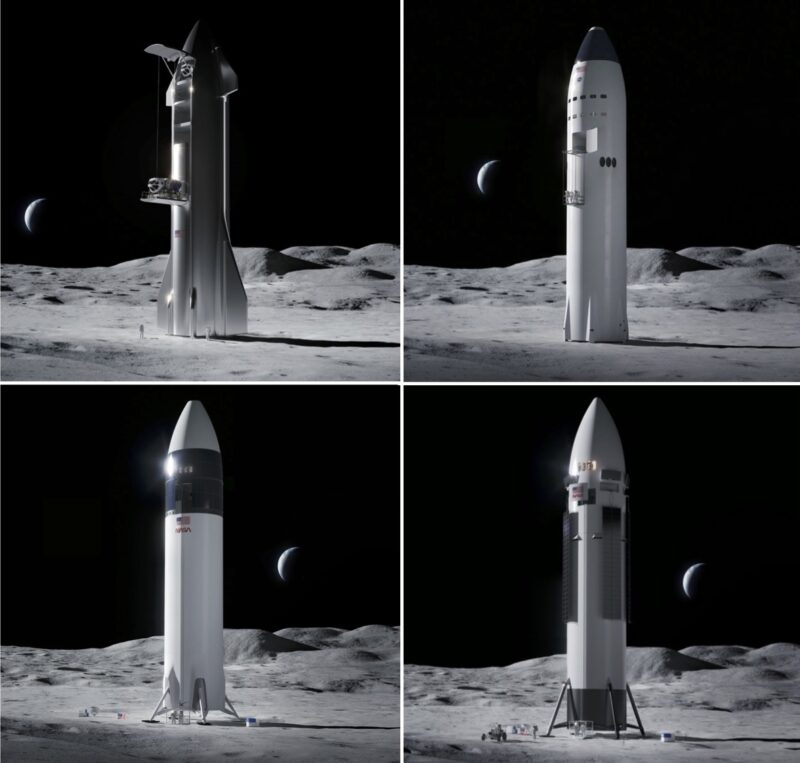
Fifty-one years after the last Lunar Module left the Moon, NASA and SpaceX have solidified the design of the next vehicle which will ferry astronauts to its surface. The revised design of Starship features a number of innovations which will allow Artemis crews to survive and thrive during their voyages of discovery, including stretched fuel tanks, rotating solar arrays, and potentially a new docking hatch. It is regrettable that the NASA and SpaceX design teams’ efforts were leaked before they could share them properly with the public. However, their work provides a fascinating glimpse into the development of one of the vehicles which will facilitate a new era of lunar exploration.






Let’s go.
I am not gettin any younger. I want to see us get to mars and beyond.
Let get a station built on the moon.
Living pods. Work and storage pods and growing pods. We can do it all!
So let’s stop the red tape test verify and GO!
Hi Robert,
Judging from your message, I am on the opposite side of the age spectrum. I wasn’t alive to see Apollo (or its 30th anniversary, for that matter). That is why I am so excited about Artemis, and why I volunteer to write about it for AmericaSpace in addition to studying candidate landing sites for the program as part of my day job. We rarely get to see events which are both historic and inspiring, and this is definitely one of them.
I have no doubt that Artemis will succeed. It may or may not happen on the timeline which we are hoping for, but the program is moving inexorably in the right direction.
So much ingenuity and yet so many problems go along with one small change, I’m ready to see them launch that spaceship
Hi Aaron,
You are absolutely correct. New requirements and unforeseen issues can lead to a phenomena which aerospace engineers informally call the “spiral of death.” I will give you an example. If the mass of a lunar lander grows, it will need to carry more fuel to reach the Moon (which necessitates larger – and heavier – fuel tanks). Since it is now carrying more cryogenic propellant, it also needs a more powerful cryocooler to prevent boil-off to space. The cryocooler, in turn, consumes more energy, so the lander needs larger solar arrays. Those expanded solar arrays have… you guessed it… more mass.
That is just one hypothetical example of the trades which must be made when you are designing a space vehicle. I have a tremendous amount of respect for the engineers who balance these factors and thereby enable the exploration of space.
So there isn’t actually anyone who thinks this is a serious, viable design for a lunar landing mission, I hope? I mean, it looks great on paper, but I’d never be caught DEAD driving a Cybertr… er… attempting to land on the moon in that.
For starters, land at a tilt even as much as one of the LMs did, your mission ends in a fireball. I sure hope Full Self Dr… er… the automatic landing guidance system is up to the task. Because, of course, a human pilot wouldn’t be able to see.
Also, wouldn’t you hate to be the last guy on the ground when the 60-foot cable hoist jams and all they can do is cut it loose and leave you behind.
At least the panels of Solar City shingles ought to work.
Agreed on all counts. Very skeptical about this plan.
Good morning,
First of all, I will preface this response by saying that I do not have any internal insight into the HLS program (and if I did, I would not leak it into the public domain). However, I think there is still cause for hope. You are correct in saying that this is a very audacious architecture. To successfully land humans on the Moon, SpaceX will need to master second-stage reuse, in-space propellant transfer, and long-term cryogenic fluid management. The Space Shuttle accomplished the first feat, but it wasn’t economical. The latter two items have never been done before.
However, SpaceX has completed projects which many deemed impossible, including vertically landing and reusing Falcon boosters and deploying a LEO broadband constellation (Starlink). NASA is very much an active participant in HLS development, and it has accomplished a wealth of “impossible” feats: landing humans on the Moon with 1960s technology, successfully launching and landing the Shuttle on its first flight, and successfully deploying the James Webb Space Telescope despite its 344 single points of failure, to name just a few.
This is just the educated prediction of one planetary scientist, but I think we will make it. It might take longer than the current 2025/2026 target date, but NASA and SpaceX have talented engineering teams. To address some of your concerns about safety, I also don’t think NASA will launch Artemis 3 until they are confident that Starship is reasonably safe for the crew.
STOP POLLUTING OUR EARTH AND SPACE WITH YOUR BILLIONAIRE TOYS.
WHY DONT YOU USE YOUR MONEY FOR THE RESTORATION OF OUR EARTH CAUSED BY HUMAN GREED.
Absolute bullshit!
Y’all know it